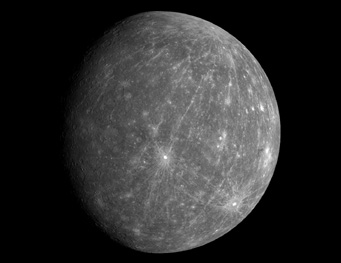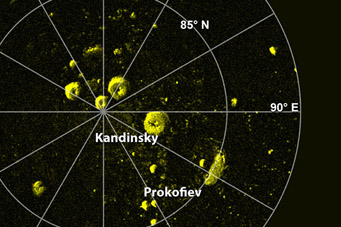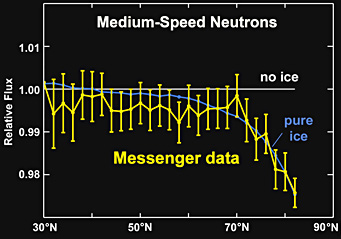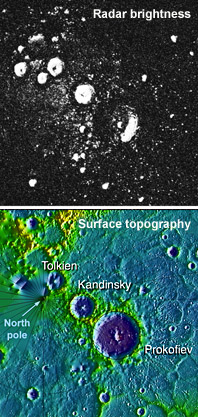Scientists with NASA's Messenger mission have announced that they've confirmed the existence of water ice in permanently shadowed craters near Mercury's poles.
Today three teams of planetary scientists announced a truly amazing result, something I've been hoping to hear for more than 20 years and expected to hear about 8 months ago. The hellish planet Mercury harbors substantial amounts of water ice — ice! — on the walls and floors of craters near its poles that are never exposed to sunlight.

Taken on October 6, 2008 from a distance of 17,000 miles (27,000 km), this Messenger image of Mercury gives no hint that permanently shadowed craters near its north pole (top) apparently contain lots of water ice.
NASA / JHU-APL/ Carnegie Inst. of Washington
This stunning revelation is detailed in a trio of reports published online today in Science Express. All are based on results from NASA's Messenger spacecraft, which has been orbiting the innermost planet for about 1½ years. I'll delve into those in a moment, but first let's step into the Wayback Machine.
In late 1991, I first got word that a team of astronomers had used one of NASA's big guns, the 230-foot (70-m) tracking antenna at Goldstone, California, to continuously illuminate Mercury with radio energy. Then they listened with the Very Large Array in New Mexico for faint radar echoes, with which they'd create a radar map of the planet.
To their complete surprise, the planet's north pole veritably lit up like a beacon. Water ice was the most likely compound to create such a strong radar echo, but how could that possibly be? "Even the youngest of budding astronomers knows that Mercury is one hot planet," wrote I in Sky & Telescope's January 1992 issue. "Mercury's midday temperatures soar to 825° Kelvin — hot enough to make molten puddles of lead, tin, and zinc."

In this radar image of Mercury’s north polar region, yellow areas denote regions of high radar reflectivity. Since their discovery in 1992, these polar deposits have been hypothesized to consist of water ice trapped in permanently shadowed areas.
National Astronomy and Ionosphere Center / Arecibo Observatory
And yet, simple geometry argued that the idea of ice at the Mercurian poles was not crazy at all but actually quite plausible. The innermost planet is so powerfully locked in the Sun's gravitational grip that the angular tilt of its spin axis, relative to its orbit, is virtually zero (just 1⁄30°). So, in principle, any ice that found its way to the floors of deep craters near the poles would never be exposed to sunlight and might well remain for a very long time.
Over the years, support for this notion of snowballs in hell only grew stronger, and Messenger's arrival in March 2011 finally gave scientists the tools they needed to prove it.
One method is to keep count of the neutrons reaching the spacecraft from Mercury. These are created when high-energy cosmic rays strike the surface and interact with atoms in rocky minerals. But hydrogen atoms gobble up slower-moving neutrons like so many atomic sponges, and a drop-off in the count rate would imply the plentiful presence of hydrogen — predominantly in H2O — near the planet's surface.

Messenger's counts medium-speed neutrons fall off at high northern latitudes, closely matching a simulated response in which water ice is assumed to completely cover permanently shadowed crater floors and walls near the planet's north pole.
NASA / JHU-APL / Carnegie Inst. of Washington
That's exactly what early results from Messenger's neutron spectrometer were hinting to its science team (as reported here last March).
Now, after many more months of slowly amassing more neutron counts and also adjusting Messenger's orbit to come somewhat closer to the planet's north pole, the presence of water ice seems inescapable. Although the neutron spectrometer's maps are too crude to resolve individual craters, there's a clear enhancement due to hydrogen in the polar regions, according to lead scientist David Lawrence of Johns Hopkins' Applied Physics Laboratory. "We can prove the water's there," he says, and measurements are consistent with the shadowed regions being filled with water ice.
So how much might be sequestered in the darkness, out of sight from the spacecraft's cameras? Lawrence says the layer of ice is at least 20 inches (50 cm) deep and could be much deeper. All told, Mercury's polar regions might hold 100 billion to a trillion tons of ice — somewhere between a Lake Tahoe and a Lake Erie's worth.

Now that scientists have finally mapped the topography surrounding Mercury's north pole (lower panel), they've concluded that the deepest hollows are a near-perfect match to anomalously reflective regions first seen two decades ago by Earth-based radars.
Radar: NAIC / Arecibo Observatory; topography: NASA / JHU-APL / Carnegie Inst. of Washington
A caveat: the neutron-spectrometer doesn't detect water directly; it indirectly detects hydrogen. So might some other hydrogen-rich substance be masquerading as water ice? Unlikely, according to additional results from Messenger's laser altimeter. It sends pulses of near-infrared light toward the surface eight times per second, then carefully computes the round-trip travel time of each reflection to determine the elevation of whatever its passing over. The instrument's science team uses these to build a topographic map of the planet over time. But the laser pulses also illuminate the ground below, and the strength of the reflections reveals how reflective the surface material is — even in the darkest shadows.
One such deep shadow lies in the 70-mile-wide crater Prokofiev, which lies with 100 miles of the planet's north pole. According to investigator Gregory Neumann (NASA/Goddard Space Flight Center), a large crescent-shaped area of the crater's poleward-facing inner rim is two to four times brighter than its surroundings, meaning is topped with something as reflective as ice. The real surprise, adds Neumann, is that the icy exposures in Prokofiev and elsewhere are surrounded by very dark material dark. He says these are likely thin blankets of material that lie atop layers of ice.
To make the case ice-tight, researchers led by David Paige (University of California, Los Angeles) used the newfound knowledge of highs and lows in the polar regions to calculate which portions of the polar regions are sometimes roasted by intense sunlight and which are not. They conclude that the floors and inner walls of many polar craters are so deeply shadowed that they never get warmer than -370°F (50 K). Any water that makes its way into these super-cold enclaves could remain there stably for a very long time.
Comets are the most likely source of all this water. Whenever one strikes Mercury, a cloud of water vapor, organic compounds, and other volatiles briefly enshrouds the planet. Some of these compounds migrate to the polar shadows and become "cold trapped" onto the surface. Paige suggests that, over time, space radiation causes the topmost layer of organics to transform into pitch-black goo, which eventually gets thick enough to insulate the pristine deposit beneath it.

How did Mercury get its water ice? Most likely it comes from comets that periodically strike the planet's surface. Some of the resulting water vapor, mixed with organic compounds and other volatiles, become "cold trapped" on the permanently shadowed floors and rims of craters in the polar regions.
NASA / UCLA / JHU-APL / Carnegie Inst. of Washington
Determining whether ice exists at Mercury's poles was actually a high priority for Messenger and its science team, notes principal investigator Sean Solomon (now at Columbia's Lamont-Doherty Earth Observatory). He explains that the water-ice hypothesis has now been subjected to three stringent tests — neutron emission, topographic plausibility, and thermal modeling — and it's passed all three. "We know of no other compound that matches [these three] characteristics," he says.
So while it might be a very long while before your local travel agent can book you a skiing vacation on Mercury's polar slopes, it's mind-expanding to think about how all that water ice got there and how its existence alters our view of solar-system evolution. For example, in answer to one rather obvious question at today's press briefing, Solomon rejected the idea that there might be life on the innermost planet. But, he allowed, "Mercury is becoming an object of astrobiological interest.
 11
11
Comments
Peter
November 30, 2012 at 6:55 am
One might conclude that all the rocky planets received water, and Earth is the standout not for the quantity delivered, but the amount held onto.
You must be logged in to post a comment.
Bruce
November 30, 2012 at 5:26 pm
That sounds like a reasonable conclusion Peter. On earth old snow piled up along the streets in air polluted cities can turn black from accumulated soot and dirt left behind as the snow melts and sublimates. What’s turning the ice black on Mercury? My guess would be hydrocarbons delivered with the comets.
You must be logged in to post a comment.
Rod
December 1, 2012 at 11:27 am
Bruce et al. I pass along this observation.
"Small impacts should have buried the surface if the ice were a billion years old, and the MESSENGER researchers believe it might be much younger than that, perhaps 50 million years old. "The ice deposits we are looking at are not ancient," says Paige. This article is reproduced with permission from the magazine Nature. The article was first published on November 29, 2012."
http://www.scientificamerican.com/article.cfm?id=ice-confirmed-on-mercury-despite-planets-solar-proximity
My observation - this report supports that the ice reported on Mercury indicates a young age here, especially when compared to the evolution model age of 4.5E+9 years old for the planet.
You must be logged in to post a comment.
Bruce
December 1, 2012 at 1:49 pm
Ok Rod, I see no problem with Mercurian ice being "perhaps 50 million years old." This also dosen't pose a problem for "the evolution model age of 4.5E+9 years old for the planet." Of cource no volatile ices could have been anywhere on Mercury's surface early in the solar system's history. I don't get too hung up over the word "evolution" either. True, I don't beleive that life arrises by chance and that new forms of life evolve by themselves, but clearly, inorganic objects like stars, planets, mountain ranges, etc. change over time.
You must be logged in to post a comment.
Rod
December 1, 2012 at 6:48 pm
Bruce interesting comments. Consider the hollows looking fresh (young), the decaying magnetic field, Messenger spectrometer revealed that the surface had a high abundance of volatile elements like Na, K, and S. These elements contradict the solar accretion model where a hot young sun with strong stellar winds strips Mercury in its youth. Their presence also contradicts the "big splat" model for the origin of Mercury, similar to the giant impact model to explain the origin of the Moon. The volatile elements should not exist in such abundance. We also have no Mercury rocks that are dated either.
Yes 4.5E+9 years old Mercury is a model age and I would not call this model age certain and evident.
You must be logged in to post a comment.
mike
December 3, 2012 at 9:34 am
Why wouldn't any water/ice just sublimate from the surface & disappear ......like an old tray of ice cubes in the dryness of a freezer? Or is it bonded to the material it is stuck to? I guess if it can be clinging to a comet, it must be able to hide on Mercury in the cold?
You must be logged in to post a comment.
Bruce
December 4, 2012 at 5:45 am
No ice ever lasts that long in my freezer Mike, but yeah, you make a good point. And wouldn’t sublimation occur faster at low or vacuum pressures? Your observation is lending support to Rod’s point that ice on Mercury can’t be very old. This also makes me wonder how the bodies that form comets can even grow at all way out in the cold beyond the snow line of our solar system. The key must be in the “dirt”, the non H2O and CO2 componets of comets. These must accumulate on the surface (like dirt on old snow) and form a protective crust somehow. And after rereading Kelley Betty’s article I quote: “Paige suggests that, over time, space radiation causes the topmost layer of organics to transform into pitch-black goo, which eventually gets thick enough to insulate the pristine deposit beneath it.” My conclusion, if we ever send a rover to investigate (which of course I hope we do) watch out for dem dar tar pits.
You must be logged in to post a comment.
MA
December 4, 2012 at 7:27 pm
Ice can exist "forever" in the vacuum of space. Comets are examples of that, until they get close to the sun, and so I don't see a problem with ice on Mercury being very old.
It comes down to physical chemistry. If you google phase diagrams for water, it will make more sense. In a vacuum at very low temperatures, the vapor pressure of water is extremely low, so it does not enter, or sublime, to the gas phase easily unless you get some energy input. For example when a comet gets close to the sun. In the freezer, the ice is about -4C and is at atmospheric pressure plus you open and close the door periodically and let warmer air in etc. At some point the ice cubes are picking up some energy along the surface. Out in deep space or in a permanently shadowed area on Mercury where it's essentially a vacuum, the rate of sublimation will be very low. That would not be the case if for example, the sun were beating down on it.
You must be logged in to post a comment.
Bruce
December 5, 2012 at 6:53 am
That was good advice and info MA. So we can take H2O ice sublimation at low temps and pressures totally off the table. That makes the solar system and all its small icy bodies make a lot more sense. Logically, ice in space can last “forever”. Thanks MA.
You must be logged in to post a comment.
Tony Flanders
December 5, 2012 at 6:59 am
Ice can't quite exist forever in outer space, but as Bruce says, it sublimates so slowly that it might as well be forever. Note that ice isn't special in this regard. Everything sublimates in outer space -- rock, iron, you name it. But the rate is sublimation is vanishingly small.
You must be logged in to post a comment.
Bruce
December 6, 2012 at 4:18 pm
MA should get the credit for pointing out the facts about sublimation Tony. And the more I think about it the more obvious it should have been; consider the extreme case of any solid at absolute zero. Sublimation would have to be impossible at 0 K. But out in the depths of space where cometary bodies form as well as in the inner solar system on permanently shadowed areas of airless bodies like our Moon and Mercury ices should be able to persist and perhaps even accumulate, like frost build up on the walls of our freezers. Tony, could what you are calling sublimation of solids in space be perhaps more correctly called weathering or erosion from energetic particle impacts? It’s hard to imagine atoms locked in solids like rock or iron evaporating from surfaces their bound to, especially at the very low temps so common in space.
You must be logged in to post a comment.
You must be logged in to post a comment.